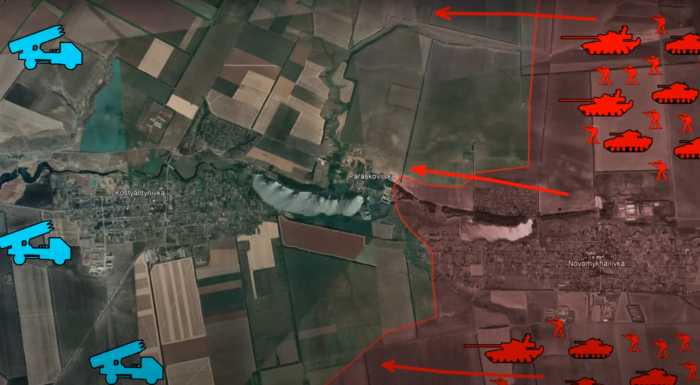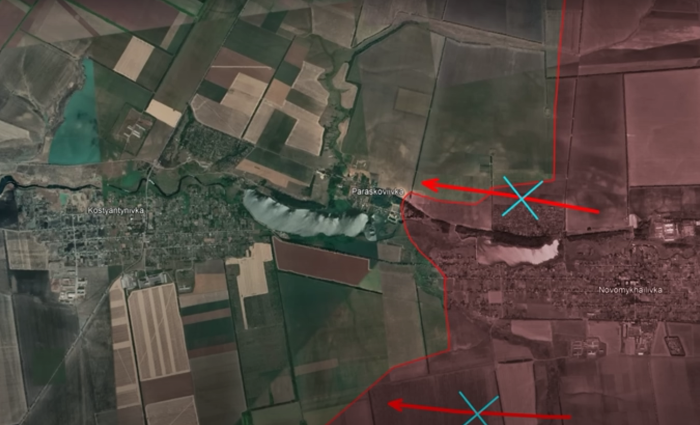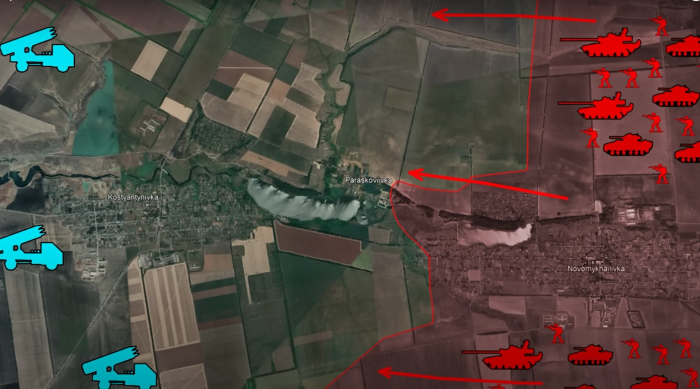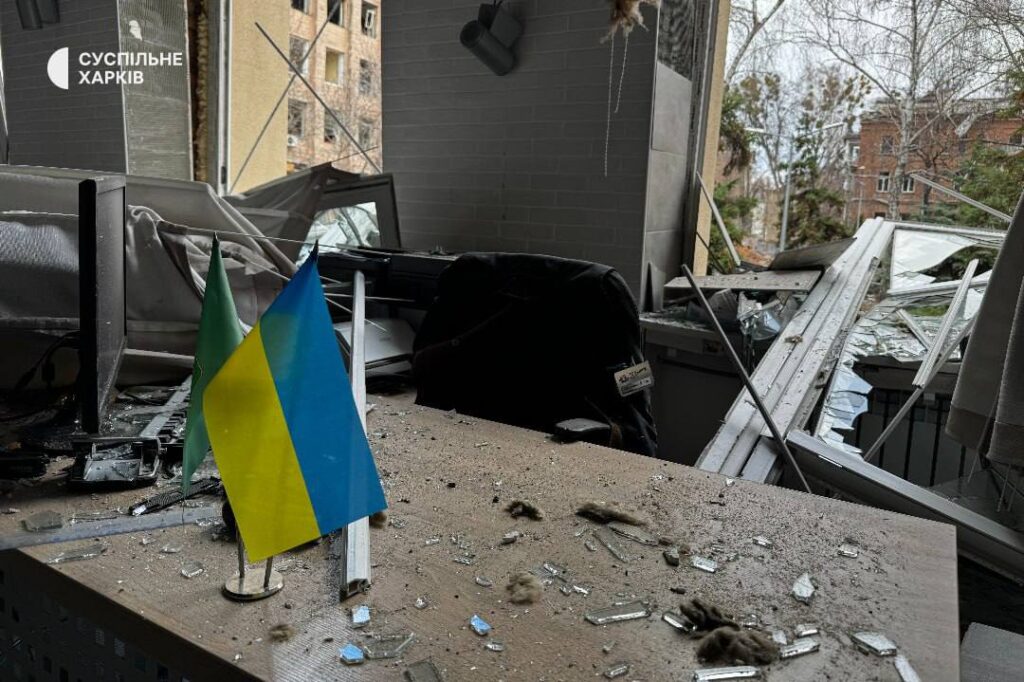Frontline report: Russian forces launch massive three-pronged assault near Novomykhailivka
A locally developed Ukrainian Shark drone operating at its 80km range limit spotted and helped destroy two Russian TOR-M1 air defense systems.


Day 854: 15 July
On 15 July, there are a lot of updates from the Kurakhove direction.
After several failed attempts to gain more ground west of Novomykhailivka in the past month, the Russians started preparing for their biggest attack so far. To achieve this, they amassed a substantial force of armored vehicles and infantry across several villages along the region’s frontline.

In response, the Ukrainians took proactive measures to thwart all Russian efforts to penetrate their defensive line.

Battles in the region are characterized by mechanized Russian assault, which the Ukrainians counter with the vast creation of minefields and the use of drones for intercepting enemy armored columns and surveillance. The first step for the Ukrainians was to open the sky for more extensive drone operations.
They began proactively hunting Russian air defense assets to achieve this and enhance their defensive capabilities, which rely heavily on drones. The following geolocated footage was taken by a Ukrainian unmanned aerial vehicle, Shark, which is locally developed and used for monitoring and adjusting fire on the battlefield.
It has an effective range of up to 80 kilometers and in this instance, it showcases its potential by operating nearly at its limit, as the distance from the frontline to the located target exceeds 60 kilometers. The drone operator identifies a pair of Russian TOR-M1 surface-to-air missile systems, which are stationary at the time but have radars capable of tracking targets while on the move. The next image shows a rapid development as one of the Russian TOR-M1 systems launches a rocket against the Ukrainian drone, which was detected. Fortunately, the missile misses within meters, and moments later, the drone captures how a called-in HIMARS strike hits the shooting air defense system, and then a second strike destroys the other one.
The destruction of such valuable Russian air defense assets opened the skies in the region, so they were able to improve their control of the air just in time as the Russians soon started their biggest assault that we have seen in recent months in the vicinity of Novomykhailivka.

As all previous attempts of the Russian forces here failed due to the Ukrainian multi-layer tactic of creating death zones with the combined use of mines, artillery, and FPV drones, this time, the Russian commanders decided to use stronger assault groups than before and to try a simultaneous attack on three vectors – to the north, to the south, and in front of the village. This tactical approach aimed at overstretching and overloading the local defense, which could have led to an effective breakthrough at one of the vectors.

After suffering heavy losses of equipment in other areas due to the Ukrainians’ effective use of anti-tank mines, the Russians prepared for an attack north of Novomykhailivka by deploying a T-72B3M tank equipped with a mine trawl, intended to clear a path for the subsequent assault group.
However, the Ukrainians’ early detection of the tank allowed them to swiftly intercept and destroy it with kamikaze drones. The released geolocated video footage shows multiple hits on the tank, successfully thwarting the initial Russian move in this direction.
Simultaneously, for their attack on the southern vector, the Russians reused the pathway west of the small village of Solodke. This route was partially cleared of mines and familiar to them from a previous offensive attempt. This time, they assembled a larger attack group consisting of tanks, various other armored vehicles, dozens of motorcycles, and infantry. Due to the size of this formation, they lost the element of surprise and were quickly spotted and engaged by soldiers of the Ukrainian 72nd Mechanized Brigade.
The Ukrainians targeted the Russians with artillery and FPV drones once they were within range. The shocking footage not only captures the deadly Ukrainian attack but also reveals the devastating aftermath, with more than 10 Russian armored vehicles destroyed, including tanks, MT-LBs, BMP-1s, and BMP-2s. The images of burned-out motorcycle remnants and heavily wounded Russian soldiers hiding underscore the suicidal nature of yet another Russian attack.
Judging by what happened up to this point and what was happening at that moment during the frontal Russian attack against Kostyantynivka, military analysts evaluated that both flank attacks north and south of Novomykhailivka were an attempt by the Russians to divert the attention of the Ukrainians from their main move. Ahead of it, Russians targeted Ukrainian defense positions in Kostyantynivka with artillery and then launched a serious assault using all available means in their arsenal, including a turtle tank, several of their most modern battle tanks T-90M and T-80, accompanied by MT-LBs and BMP-3s.
The extent of the assets used showcases the magnitude of the Russian ambition to enter this village and establish a foothold there. Still, the geolocated footage the Ukrainians shared again highlights their preparedness and defensive capabilities when dealing with such powerful offensive endeavors.
The dynamic tactic used by the Ukrainians included the use of powerful anti-tank mines, guided anti-tank rockets, and FPV drones, as well as the American-made Switchblade-600 loitering munition. Once all armored vehicles were disabled the Ukrainians again used some of their best drone operators to finish them off as well as to hunt down any surviving Russian soldiers, which effectively ended this main Russian frontal attack and put them under pressure to conduct yet another operational pause.
Overall, the scale of the Russian attacks has increased dramatically, as they opted to conduct a three-dimensional assault with larger and better-equipped units. Ukrainian forces were well-prepared for this development, targeting Russian air defense systems shortly before these attacks.
This proved invaluable, allowing them to monitor the battlefield and the Russian rear, adjusting their tactics to destroy enemy equipment and personnel before they reached the zero line. The situation in the Kurakhove direction remains dynamic, and even though the Ukrainians have forced the Russians into an operational pause to regroup and replenish their units, another assault is surely imminent.
In our daily frontline report, we pair up with the military blogger Reporting from Ukraine to keep you informed about what is happening on the battlefield in the Russo-Ukrainian war.
Read also:
You could close this page. Or you could join our community and help us produce more materials like this.
We keep our reporting open and accessible to everyone because we believe in the power of free information. This is why our small, cost-effective team depends on the support of readers like you to bring deliver timely news, quality analysis, and on-the-ground reports about Russia's war against Ukraine and Ukraine's struggle to build a democratic society.
A little bit goes a long way: for as little as the cost of one cup of coffee a month, you can help build bridges between Ukraine and the rest of the world, plus become a co-creator and vote for topics we should cover next. Become a patron or see other ways to support.



